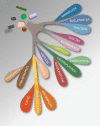Revisions to the Classification, Nomenclature, and Diversity of Eukaryotes
- PMID: 30257078
- PMCID: PMC6492006
- DOI: 10.1111/jeu.12691
Revisions to the Classification, Nomenclature, and Diversity of Eukaryotes
Abstract
This revision of the classification of eukaryotes follows that of Adl et al., 2012 [J. Euk. Microbiol. 59(5)] and retains an emphasis on protists. Changes since have improved the resolution of many nodes in phylogenetic analyses. For some clades even families are being clearly resolved. As we had predicted, environmental sampling in the intervening years has massively increased the genetic information at hand. Consequently, we have discovered novel clades, exciting new genera and uncovered a massive species level diversity beyond the morphological species descriptions. Several clades known from environmental samples only have now found their home. Sampling soils, deeper marine waters and the deep sea will continue to fill us with surprises. The main changes in this revision are the confirmation that eukaryotes form at least two domains, the loss of monophyly in the Excavata, robust support for the Haptista and Cryptista. We provide suggested primer sets for DNA sequences from environmental samples that are effective for each clade. We have provided a guide to trophic functional guilds in an appendix, to facilitate the interpretation of environmental samples, and a standardized taxonomic guide for East Asian users.
Keywords: Algae; amoebae; biodiversity; ciliate; ecology; flagellate; fungus; microbiology; parasite; plankton; protozoa; systematics; taxonomy.
© 2019 International Society of Protistologists.
Figures

Similar articles
-
Hydroids (Cnidaria, Hydrozoa) from Mauritanian Coral Mounds.Zootaxa. 2020 Nov 16;4878(3):zootaxa.4878.3.2. doi: 10.11646/zootaxa.4878.3.2. Zootaxa. 2020. PMID: 33311142
-
The revised classification of eukaryotes.J Eukaryot Microbiol. 2012 Sep;59(5):429-93. doi: 10.1111/j.1550-7408.2012.00644.x. J Eukaryot Microbiol. 2012. PMID: 23020233 Free PMC article.
-
Diversity of Heterotrophic Protists from Extremely Hypersaline Habitats.Protist. 2015 Sep;166(4):422-37. doi: 10.1016/j.protis.2015.06.001. Epub 2015 Jun 18. Protist. 2015. PMID: 26202993
-
The phagotrophic origin of eukaryotes and phylogenetic classification of Protozoa.Int J Syst Evol Microbiol. 2002 Mar;52(Pt 2):297-354. doi: 10.1099/00207713-52-2-297. Int J Syst Evol Microbiol. 2002. PMID: 11931142 Review.
-
Diversity and ecology of protists revealed by metabarcoding.Curr Biol. 2021 Oct 11;31(19):R1267-R1280. doi: 10.1016/j.cub.2021.07.066. Curr Biol. 2021. PMID: 34637739 Review.
Cited by
-
Recurrent association between Trichodesmium colonies and calcifying amoebae.ISME Commun. 2024 Nov 4;4(1):ycae137. doi: 10.1093/ismeco/ycae137. eCollection 2024 Jan. ISME Commun. 2024. PMID: 39564584 Free PMC article.
-
Evolution of promoter-proximal pausing enabled a new layer of transcription control.bioRxiv [Preprint]. 2024 Oct 12:2023.02.19.529146. doi: 10.1101/2023.02.19.529146. bioRxiv. 2024. PMID: 39416036 Free PMC article. Preprint.
-
Elevated Atmospheric Co2 Levels Impact Soil Protist Functional Core Community Compositions.Curr Microbiol. 2024 Oct 16;81(12):411. doi: 10.1007/s00284-024-03930-3. Curr Microbiol. 2024. PMID: 39414704 Free PMC article.
-
National-scale distribution of protists associated with sorghum leaves and roots.Environ Microbiol Rep. 2024 Oct;16(5):e70024. doi: 10.1111/1758-2229.70024. Environ Microbiol Rep. 2024. PMID: 39351609 Free PMC article.
-
Addictive manipulation: a perspective on the role of reproductive parasitism in the evolution of bacteria-eukaryote symbioses.Biol Lett. 2024 Sep;20(9):20240310. doi: 10.1098/rsbl.2024.0310. Epub 2024 Sep 18. Biol Lett. 2024. PMID: 39288812 Review.
References
-
- Adl, M. S. , Leander, B. S. , Simpson, A. G. B. , Archibald, J. M. , Anderson, O. R. , Barta, J. R. , Bass, D. , Bowser, S. S. , Brugerolle, G. , Farmer, M. A. , Karpov, S. , Kolisko, M. , Lane, C. E. , Lodge, J. , Lynn, D. H. , Mann, D. G. , Meisterfeld, R. , Mendoza, L. , Moestrup, Ø. , Mozley‐Standridge, S. E. , Smirnov, A. V. & Spiegel, F. W. 2007. Diversity, nomenclature and taxonomy of protists. Syst. Biol., 56(4):684–689. - PubMed
-
- Adl, M. S. , Simpson, A. G. B. , Farmer, M. A. , Andersen, R. A. , Anderson, O. R. , Barta, J. R. , Bowser, S. S. , Brugerolle, G. , Fensome, R. A. , Fredericq, S. , James, T. Y. , Karpov, S. , Kugrens, P. , Krug, J. , Lane, C. E. , Lewis, L. A. , Lodge, J. , Lynn, D. H. , Mann, D. G. , McCourt, R. M. , Mendoza, L. , Moestrup, Ø. , Mozley‐Standridge, S. E. , Nerad, T. A. , Shearer, C. A. , Smirnov, A. V. , Spiegel, F. W. & Taylor, F. J. R. 2005. The new classification of eukaryotes with emphasis on the taxonomy of protists. J. Eukaryot. Microbiol., 52(5):399–451. - PubMed
-
- Adl, S. M. , Simpson, A. G. , Lane, C. E. , Lukeš, J. , Bass, D. , Bowser, S. S. , Brown, M. W. , Burki, F. , Dunthorn, M. , Hampl, V. , Heiss, A. , Hoppenrath, M. , Lara, E. , Le Gall, L. , Lynn, D. H. , McManus, H. , Mitchell, E. A. D. , Mozley‐Stanridge, S. E. , Parfrey, L. W. , Pawlowski, J. , Rueckert, S. , Shadwick, L. , Schoch, C. , Smirnov, A. & Spiegel, F. W. 2012. The revised classification of eukaryotes. J. Eukaryot. Microbiol., 59:429–493. - PMC - PubMed
-
- Berney, C. , Ciuprina, A. , Bender, S. , Brodie, J. , Edgcomb, V. , Kim, E. , Rajan, J. , Wegener Parfrey, L. , Adl, S. , Audic, S. , Bass, D. , Caron, D. A. , Cochrane, G. , Czech, L. , Dunthorn, M. , Geisen, S. , Oliver Glöckner, F. , Mahé, F. , Quast, C. , Kaye, J. Z. , Simpson, A. G. B. , Stamatakis, A. , del Campo, J. , Yilmaz, P. & de Vargas, C. 2017. UniEuk: time to speak a common language in protistology! J. Eukaryot. Microbiol., 64:407–411. 10.1111/jeu.12414 - DOI - PMC - PubMed
Publication types
MeSH terms
Grants and funding
LinkOut - more resources
Full Text Sources
Other Literature Sources
Research Materials


